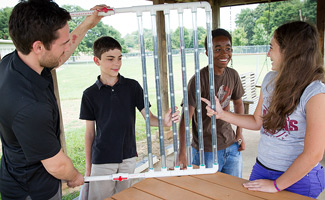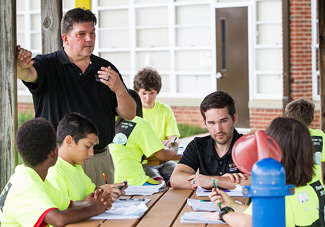The changing shape of solar
It can suck up the heat of a hot summer’s day and turn it into electricity.
The Hybrid Sterling Energy Generator (HySterE) panel is one of the world’s first combined photovoltaic and thermal collection generators.
“It could transform how we use the sun’s energy,” said David Carroll, HySterE’s principal developer and director of Wake Forest’s Center for Nanotechnology and Molecular Materials.
Carroll explains that solar technologies today utilize only a fraction of the sun’s energy. He said this is because they are made of silicon, a material that only absorbs visible light or energy from the sun with a wavelength between 400 and 700 nanometers.
Rather than increasing the efficiency or lowering the cost of existing solar cells, Carroll’s team came up with a way to increase the amount of energy from the solar spectrum you can gather.
“The solar spectrum you see with your eyes has a lot of power locked up in it,” he said. “But if you think about the infrared, or heat energy, there is a lot of power locked away there as well. To date, this energy has been wasted.”

Graduate student Corey Hewitt and some of the students examine the HySterE solar panel that the students built.
Unlike its conventional counterparts, a HySterE panel is able to collect both visible light and thermal energy. It consists of clear tubes of inexpensive plastic filled with a nano-engineered dye and ethylene glycol (radiator fluid). The dye absorbs heat from the environment around it and transfers this to the ethylene glycol, superheating the fluid. This liquid is then fed through a mini-turbine about the size of a Starbucks cup. On the back of each tube, a strip of photovoltaic silicon is placed to gather visible light.
Carroll said in comparison to a 4×6-foot Si solar panel that might produce as much as 500W on a roof, a HySterE I panel of the same size can produce 1.2 kW of electrical power. Moreover, power production lasts over a larger part of the day – not just when the sun is high in the sky.
Carroll said that this means more electricity per hour over the course of a day. This could in turn dramatically improve the return on investment with a HySterE I system.
To top things off, Carroll said that 60 percent of a HySterE panel can be made from recycled materials. “The only thing that is not recycled is the silicon and the generator itself,” he said.

Physics professor David Carroll (left) talks with the students as they work on a problem.
On Aug. 5-9, Carroll and a team of graduate students worked with 6th-8th graders enrolled in Hanes Middle School’s “Power Up!” summer camp to assemble the first commercial HySterE system. The campers made actual measurements to assess system performance and analyze the potential of the system for use in the region, Carroll said.
“We are going to help this school meet their goal of educating the next generation of scientific innovators by exposing these kids to cutting-edge technology,” Carroll said. “This is an exciting way to pique the interest of young people in pursuing a career in science.”
Categories: Environment & Sustainability, Research & Discovery, University Announcements
Media Contact
Wake Forest News
media@wfu.edu
336.758.5237



